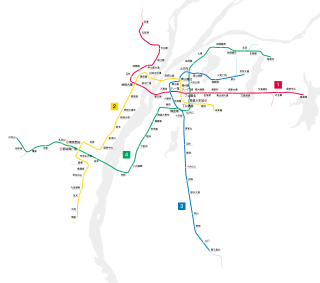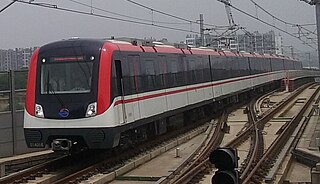
The Beijing Subway is the rapid transit system of Beijing Municipality that consists of 29 lines including 24 rapid transit lines, two airport rail links, one maglev line and two light rail tram lines, and 522 stations. The rail network extends 879 km (546 mi) across 12 urban and suburban districts of Beijing and into one district of Langfang in neighboring Hebei province. In December 2023, the Beijing Subway became the world's longest metro system by route length, surpassing the Shanghai Metro. The system shortly returned to second place between December 1 and 15, 2024, before regaining the title with the opening of Line 3, Line 12 and the remaining Changping line extension. With 3.8484 billion trips delivered in 2018 and single-day ridership record of 13.7538 million set on July 12, 2019, the Beijing Subway was the world's busiest metro system in the years immediately prior to the outbreak of the COVID-19 pandemic.

The Chongqing Rail Transit is the rapid transit system in the city of Chongqing, China. In operation since 2005, it serves the transportation needs of the city's main business and entertainment downtown areas and inner suburbs. As of December 2023, CRT consisted of eleven lines, with a total track length of 523.68 km (325 mi). Lines 1, 4, 5, 6, 9, 10, 18, the Loop line and Jiangtiao line are conventional heavy-rail metro lines, while Lines 2 and 3 are high-capacity monorails. To keep up with urban growth, construction is under way on Line 18 and several other lines, in addition to extensions to Lines 5, 6 and 10.

The Chengdu Metro is the rapid transit system of Chengdu, the capital of Sichuan, China. With the opening of Line 1 on 27 September 2010, the system has fifteen subway lines and one light rail line. It has subsequently undergone rapid expansion. Since the opening of Lines 6, 8, 9, and 17 on 18 December 2020, the Chengdu Metro is the 3rd longest metro system in the world.

Urban rail transit in China encompasses a broad range of urban and suburban electric passenger rail mass transit systems including subway, light rail, tram and maglev. Some classifications also include non-rail bus rapid transport.

Line 11 is a northwest–southeast line of the Shanghai Metro network. Since October 2013, Line 11 serves Kunshan city, making it is the second intercity metro in China after the Guangfo Metro and the first that crosses a provincial boundary. With a single-line mileage of 82.386 kilometres (51.192 mi), it is the third-longest single-line subway line in China, after Line 6 in Chongqing, which is 85.6 km (53.2 mi) long and Line 7 in Wuhan with a length of 83.6 km (51.9 mi). The line is colored brown on system maps.

Line 8 of the Beijing Subway is a rapid transit line in Beijing. It sits on the central axis of Beijing. Line 8's color is green. It is 49.5 km (30.8 mi) in length with 35 stations. The most recent extension is the central section from National Art Museum to Zhushikou, opened on 31 December 2021.

Zhengzhou Metro is a rapid transit rail network serving urban and suburban districts of Zhengzhou, the capital city of Henan province. It is operated by the state owned Zhengzhou Metro Group. As of December 2024, the network has 13 operational lines, with a network length of 450 km (279.6 mi) and 217 stations. Opened on 28 December 2013, it is the first metro system in Henan province, and 18th in mainland China.

Line 16 is a rapid transit line serving the south-eastern suburban areas of Shanghai. The line was formerly known as the Lingang line. It was originally designated as Line 21 and was planned as the south part of line 11. The line runs entirely in Pudong New Area, starting from Longyang Road, via Shanghai Wild Animal Park, Huinan Town, ending at Dishui Lake in Nanhui New City. The line is 59 km (37 mi) long and has 13 stations of which three are underground and the rest elevated. Construction begun in early 2009, and the line opened on 29 December 2013. The second phase was completed at the end of 2014.

The Harbin Metro is the rapid transit system of Harbin, the provincial capital of Heilongjiang Province in northeastern China. The system began operation on 26 September 2013 with the opening of Line 1. The system has a total of three lines.

Nanchang Metro, officially Nanchang Rail Transit, is a rapid transit system in Nanchang, Jiangxi, China. As of 2021, four lines are operational. The Metro opened for commercial operation in December 2015. The network is currently 128.3 km (79.7 mi) in length with 4 lines. A total length of 163 km (101.3 mi) of network is planned, with Line 5 which is currently under planning.

The Line 2 of Wuhan Metro is the first underground metro line crossing the Yangtze River. The line started its trial run on September 25, 2012, and officially opened on December 28, 2012. It is Wuhan's second metro line after Line 1, and the city's first underground line, since Line 1 is mostly elevated. Line 2 runs in a northwest–southeast direction, connecting Hankou and Wuchang, including Hankou Railway Station and major commercial districts.

Nanning Metro or Nanning Rail Transit (NNRT) is a rapid transit system in Nanning, the capital of Guangxi Zhuang Autonomous Region in China.

Lanzhou Metro or Lanzhou Rail Transit is a rapid transit system in Lanzhou, Gansu, China.

Line 1 of the Zhengzhou Metro is a rapid transit line running from west to east Zhengzhou. It opened on the 28 December 2013. This line is currently 41.2 km long with 30 stations.

Line 1 of the Changsha Metro is a line of the Changsha Metro that runs across Changsha, from Jinpenqiu in the north to Shangshuangtang in the south. It serves 25 stations over 33.43 km, and is coloured red on the system map. It first began operations on June 28, 2016.

Line 3 of Zhengzhou Metro is a rapid transit line in Zhengzhou that runs in a northwest - southeast direction. The line uses six car Type A trains. The line opened on December 26, 2020.

Line 6 of Zhengzhou Metro is a rapid transit line in Zhengzhou, Henan Province, China. The line uses 6-car Type A trains.
The Zhengzhou subway flooding incident refers to the severe flooding that occurred on Zhengzhou Metro Line 5 on July 20, 2021, during a heavy rainstorm. Despite the weather, the metro line continued to operate, and rainwater broke through the retaining wall of the Wulongkou parking lot, flooding the train tunnel. Official reports from the government stated that the incident resulted in 14 deaths and 5 injuries. However, the death toll has been widely questioned because the trains were covered with black cloth during the subsequent search and rescue operations, preventing the inspection of their interiors.


















